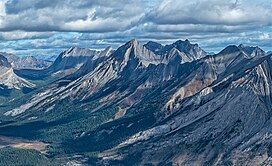| Mount Mercer | |
|---|---|
 South aspect of Mount Mercer (centre) South aspect of Mount Mercer (centre) | |
| Highest point | |
| Elevation | 2,970 m (9,744 ft) |
| Prominence | 295 m (968 ft) |
| Parent peak | Beersheba Peak (3,054 m) |
| Isolation | 1.93 km (1.20 mi) |
| Listing | Mountains of Alberta |
| Coordinates | 50°55′24″N 115°31′13″W / 50.92333°N 115.52028°W / 50.92333; -115.52028 |
| Naming | |
| Etymology | Malcolm Mercer |
| Geography | |
  | |
| Interactive map of Mount Mercer | |
| Country | Canada |
| Province | Alberta |
| Protected area | Banff National Park |
| Parent range | Sundance Range Canadian Rockies |
| Topo map | NTS 82J13 Mount Assiniboine |
| Geology | |
| Rock age | Cambrian |
| Mountain type | Fault block |
| Rock type | Limestone |
Mount Mercer is a 2,970-metre (9,744-foot) mountain summit located in Alberta, Canada.
Description
Mount Mercer is set within Banff National Park, three kilometers east of the Continental Divide, and is situated near the southern end of the Sundance Range which is a subset of the Canadian Rockies. Located four kilometers east of Assiniboine Pass, Mount Mercer is a remote peak which is not visible from any road. Mount Mercer's nearest higher neighbor is Mount Allenby, 1.9 km (1.2 mi) to the north-northwest, and Mount Assiniboine is 10 km (6.2 mi) to the southwest. Precipitation runoff from the mountain drains into Mercer and Bryant creeks which empty to the nearby Spray Lakes Reservoir. Topographic relief is significant as the summit rises 1,130 meters (3,700 feet) above Bryant Creek Valley in less than 2 kilometers (1.24 mile).
Geology
Mount Mercer is composed of limestone which is a sedimentary rock laid down during the Precambrian to Jurassic periods. Formed in shallow seas, this sedimentary rock was pushed east and over the top of younger rock during the Laramide orogeny.
Climate
Based on the Köppen climate classification, Mount Mercer is located in a subarctic climate zone with cold, snowy winters, and mild summers. Winter temperatures can drop below −20 °C with wind chill factors below −30 °C.
Etymology
Mount Mercer is named in remembrance of Major-General Malcolm Mercer (1859–1916), a Canadian general who led the 3rd Canadian Division during the First World War before he was killed in action at Mount Sorrel in Belgium on June 2, 1916. He was the highest ranking Canadian killed in the war. The mountain's toponym was officially adopted in 1924 by the Geographical Names Board of Canada.
Gallery
See also
References
- ^ "Mount Mercer, Peakvisor.com". Retrieved November 7, 2022.
- ^ William Lowell Putnam, Glen W. Boles (1973), Climber's Guide to the Rocky Mountains of Canada, South, American Alpine Club, p. 109
- ^ "Mount Mercer". Geographical Names Data Base. Natural Resources Canada. Retrieved 2022-11-07.
- Belyea, Helen R. (1960). The Story of the Mountains in Banff National Park (PDF). parkscanadahistory.com (Report). Ottawa: Geological Survey of Canada. Archived (PDF) from the original on 2015-10-02. Retrieved 2019-09-13.
- Gadd, Ben (2008). Geology of the Rocky Mountains and Columbias.
- Peel, M. C.; Finlayson, B. L.; McMahon, T. A. (2007). "Updated world map of the Köppen−Geiger climate classification". Hydrol. Earth Syst. Sci. 11 (5): 1633–1644. Bibcode:2007HESS...11.1633P. doi:10.5194/hess-11-1633-2007. ISSN 1027-5606.
- "Mount Mercer". cdnrockiesdatabases.ca. Retrieved 2022-11-07.
- The Canada Gazette, February 23, 1918, p. 2862
External links
- Mount Mercer: weather forecast
- Parks Canada web site: Banff National Park

